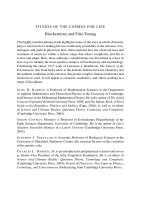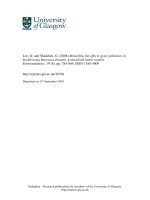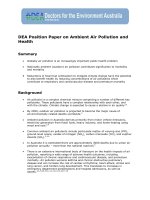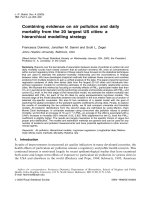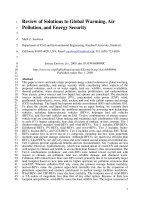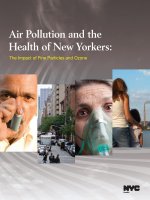Summary of the PERN Cybersminar Air Pollution and Health Linkages doc
Bạn đang xem bản rút gọn của tài liệu. Xem và tải ngay bản đầy đủ của tài liệu tại đây (125.65 KB, 7 trang )
Summary of the PERN Cybersminar
Air Pollution and Health Linkages
1-15 December 2003
This Population-Environment Research Network (PERN) Cyberseminar sought to identify the
most pressing issues and topics for research and policy in linking air pollution (both indoor and
outdoor) and human health. More than 340 researchers were subscribed to the seminar’s
discussion list, and there were 77 postings, including six panel statements by the following
experts:
Dr. Aaron Cohen, Health Effects Institute, Boston, Massachusetts, USA
Dr. Majid Ezzati, Harvard University, Boston, Massachusetts, USA
Dr. Adrian Fernandez, Leonora Rojas-Bracho, and Miriam Zuk, National Institute of
Ecology, Mexico
Dr. Bart Ostro, Ph.D., Chief, Air Pollution Epidemiology Unit, California Office of
Environmental Health Hazard Assessment, Oakland, California, USA
Dr. Sumeet Saksena, East-West Center, Honolulu, Hawaii, USA
Dr. Kirk Smith, University of California, Berkeley, California, USA
The seminar background paper by Dr. Vinod Mishra (East-West Center) and a complete archive
of postings to the seminar discussion list can be found at
/> (click on “View Postings”). This
report serves as a summary of the discussion by major thematic area – Air Pollution and the
Burden of Disease, Urban Air Pollution, Indoor Air Pollution, and Tools and Methods – and
includes a list of resources and citations mentioned by participants. Wherever possible, affiliation
information is provided for those who made contributions.
Air Pollution and the Burden of Disease
In his panel statement, Aaron Cohen reported that considerable uncertainties exist in the estimates
of that portion of the global burden of disease attributable to air pollution. In a study he led, they
estimated that outdoor air pollution, characterized as fine particulate matter (PM2.5, or particulate
matter smaller than 2.5 microns) is currently responsible for about 0.80 million (1.2% of world
total) premature deaths and 6.4 million (0.5% of world total) Years of Life Lost (YLL) in the
populations of the world's large cities (>100,000). He reports that the estimates were subject to
considerable uncertainty due largely to the lack of air pollution measurements and information
about the shape of concentration-response functions in developing countries. He cited a need for:
• Better estimates not only of ambient concentrations but also of the characteristics of
outdoor air pollution, including the contribution of various sources and the size
distribution of particulate matter (PM).
• Epidemiologic studies of the effects of long-term exposure to air pollution and mortality
from chronic cardio-vascular and respiratory disease. These should be designed to
provide age- and disease-specific estimates of air pollution effects.
• Epidemiologic studies of the effect of air pollution on the incidence of acute and chronic
cardiovascular and respiratory disease in adults and children (e.g., acute respiratory
infections).
Lorena Rojas Bracho reported on a study conducted in Ciudad Juárez, a large Mexican border
city, which found that ambient PM10 could increase the risk of mortality due to respiratory
causes of poor children between the ages of 1 month and one year old. The authors reported a 62
percent increase in mortality in this age and SES group for a 20µg/m3 PM10 increase.
Duc Hiep (Department of Environment and Conservation, New South Wales, Australia) agreed
with Dr. Cohen’s assessment about the inadequacy of PM data (PM10 and PM2.5) in health
effect studies of air pollution. In the majority of cases, motor vehicles and industry are the main
sources of PM. Particle size is important but so is the composition of volatile organic compounds
and soot in particles (especially PM2.5).The quality of fuels (including diesel) are different in
different countries. So a particular health effect of PM study in a particular city may not give
comparative results to another study in a different city or country. Furthermore the different
methods, protocols and quality assurances of measuring PM10 and PM2.5 are contributing to the
uncertainty in comparative studies.
In his panel statement, Bart Ostro wrote that scores of studies conducted on five continents have
documented consistent associations between short-term exposures to ambient particulate matter
measured as PM10 and PM2.5 and daily counts of mortality and hospitalization (CARB 2002).
These fairly consistent associations suggest that exposure to ambient air pollution is a risk factor
for exacerbation of pre-existing cardiac and respiratory illnesses, though pathophysiological
mechanisms are not well understood. In contrast, much less is known about: (1) the health
impacts of longer-term (i.e., one year or more) exposure, particularly on the development of
cardiac or respiratory diseases; and (2) the roles of specific sources, especially traffic-associated
emissions, with respect to the pathogenesis of chronic illness.
Ostro’s statement sparked some discussion on agricultural land-burning, as well as dust during
dry season. Wisa Supanpaiboon wrote to say that in rural areas in Thailand, after rice harvesting
farmers burn the stubble and crop residues and a large area is covered by smoke. Ostro responded
that he is leading a team to examine the association between daily exposures to particulate matter
(PM), including particles from tobacco leaf burning, and mortality in Chiangmai. Puttanna S.
Honaganahali (Institute for Social and Economic Change, India) stated that, in India, agricultural
burns are seasonal events that last from a fortnight to a month, and depending on water
resources, once or twice a year. M.S.R. Murthy (Department of Population Studies, Sri
Venkateswara University) added that farmers in India are exposed to coarse particulates from
airborne fine soil particles due to farm activity and pulverization by vehicles, and Ramakrishnan
Narayana added yet other air pollutant risks to the list: brick kilns, manual mixing of cement and
sand in the building construction sector, rice mills, cotton and textiles mills, silk weaving, and
mosquito coils.
David Pepper (Asthma Education and Management Unit, UCSF-Fresno) wrote to say that in 2002
Fresno, California had more than 100 days last year of PM and Ozone exceedances. He inquired
about comparative figures for Mexico City, Bangkok and Shanghai, and asked participants if
there is an established link with asthma. Roger-Mark DeSouza (Population Reference Bureau)
provided a partial response by pointing to a PRB publication entitled Household Transportation
Use and Urban Air Pollution (1999; see bibliography),
which includes case studies of Mexico
City and Bangkok along with some basic data. Bart Ostro responded that there are many studies
indicating that short-term exposure to particulate matter (PM) or ozone will exacerbate asthma,
but only a few studies suggest that these common air pollutants will actually initiate asthma. He
added that because asthma is a multi-factoral disease, it is not likely that air pollutant levels in
these cities would be good predictors of asthma rates. Joseph Schirmer (Wisconsin Department of
Health and Family Services) contributed a summary of a Lancet article that provides evidence
that ozone exposure may indeed be a contributing cause of asthma (McConnell et al. 2002). The
authors collected local measures of variation in air pollutants over time and individual
questionnaires about participation in sports and time spent outdoors. The results indicate that for
children living in communities with high ozone concentrations, participation in sports was
associated with a higher probability of developing asthma. A discussion ensued about seasonal
asthma rates, and what might account for spikes that occurred in early September. Ostro
suggested it might have to do with children returning to school, or the increase could be related to
tree pollens.
In a separate posting, Pepper inquired what should be the priorities in terms of greatest health
benefit for each dollar spent in control - e.g. should we be focusing on diesel, indoor coal, solid
fuels used indoors, all sulfur containing sources, pesticides, fumigants? A partial response was
provided by Kirk Smith’s panel statement, which addressed the issue of Intake Fractions (IF). IF
is that proportion of ambient air pollution that is actually inhaled, and it varies by many orders of
magnitude for different sources. In other words, the fraction of released pollutant reaching the
breathing zone (or actually inhaled) greatly depends on the location/timing of the source
emissions with respect to the places people spend time. Such differences in IF can overwhelm
differences in the hazard of a source based purely on toxicity. Thus, in setting control priorities
among source categories, there is a clear need to understand their relative IF, i.e., the differential
potential for different sources to create exposure. The potential for increased economic efficiency
through substituting "exposure trading" for "emissions trading" and more effective regulation in
general are significant. The basic approach would be to weight the emissions of a class of
sources by their relative IF. In his statement, Sumeet Saksena explored a similar issue, stating that
nearly all of the previous epidemiological studies have aimed at quantifying concentration-
response relationships. He argued that now there is a need to quantify the more meaningful
exposure-response relationships.
In their panel statement, Adrian Fernandez et al. pointed out that the lack of research in
developing countries leaves them at a disadvantage in terms of developing policy: “Since no
cohort mortality study has been conducted in Mexico, we must rely on studies conducted in the
United States. Given population and social differences, such as age structure, poverty, SES,
nutrition, and health status between the study population and that of Mexico, as well as
differences in PM and other pollutants dynamic ranges between Mexico City and cities where
cohort studies have been conducted, is it legitimate to apply these concentration-response
coefficients to Mexico?” Saksena echoed these concerns in his statement: “I hypothesize that the
following factors are a few of the major reasons why exposure levels are likely to be different (in
magnitude and distribution) in developing countries: differences in source composition (e.g.
higher fraction of two-wheel vehicles, natural dust, etc.); differences in pollutant mixes; lesser
use of mechanized ventilation in homes and buildings; differences in activity patterns due to
socio-economic, cultural and climatic reasons; and differences in land use and zoning patterns
(determining who lives where).” As a result of these differences, some of the emerging state of
the art methodologies for studying pollution-health linkages would need to be adapted to
developing country situations.
Urban Air Pollution
J. Austin Kerr (Environmental Science Associates, California, USA) is responsible for evaluating
impacts to air quality in Environmental Impact Reports (EIR) pursuant to the California
Environmental Quality Act (CEQA). Most Air Quality sections of EIRs discuss the location of
“sensitive receptors” (e.g., schools, hospitals, and convalescent homes) that could be affected by
adverse changes in air quality resulting from the project being reviewed. He asked how others
think “sensitive receptors” should be defined. Honaganahalli responded that in India and China
the practice is to divide a city into zones, such as industrial, commercial and residential and,
recently, sesitive zones such as hospitals. The regulators specify different ambient air quality
standards for each zone within the same city or airshed. He expressed doubt about dividing an
airshed based on socioeconomic criterion when fluid flows are only constrained by topographical
features, and questioned the actual enforcement of such standards.
Honaganahali added that the US National Ambient Air Quality Standards (NAAQS) are health-
based standards for criterial pollutants that apply for an airshed as a whole. These standards have
the health risks factored in them, which basically means that if an airshed is compliant with the
US-NAAQS then the effects of criteria pollutants may not be in evidence. Addressing every
individual "hot spot" may be done but at a cost to society and economic development, as the bar
will have to be lowered further (or the standard has to be raised).
B.C. Nagaraja (Centre for Ecological Sciences, Indian Institute of Science) suggested that one
means of reducing urban air pollution is planting trees. He stated that increases in urban air
pollution in India coincided with decreases in tree cover. Brad Bartholomew forwarded an
Associated Press article to the discussion which cites atmospheric scientists who have studied the
effects of urban air pollution on precipitation down wind. According to the article, eastward-
blowing pollution in California induces a precipitation deficit across the Sierra Nevada mountain
range equal to about 1 trillion gallons of water a year. This may create other health risks,
independent of direct inhalation of smoke.
Sarath Guttikunda (The World Bank) reported on some research into air pollution and acid rain in
China. He reports that emission control efforts in the north will benefit from access to greater
quantities of low-sulfur coal, whereas the lack of low-sulfur coal in the South will significantly
increase the cost of emissions control. Other findings suggest that gaining a better scientific
understanding of the impacts of sulfur emissions, and improving estimates of the relative benefits
of different control options, are two important pieces of information for leveraging local
implementation efforts.
Indoor Air Pollution
Kai Lee (Williams College, USA) asked if the Global Burden of Disease study estimates for
premature mortality from air pollution take into account indoor air pollution. Vinod Mishra (East-
West Center, USA) responded, “The calculations of disease burden due to outdoor air pollution
do not account for indoor air quality. Disease burden due to indoor smoke from household use of
biomass and coal for cooking and space heating is estimated separately. According to the 2002
World Health Report, it is estimated to account for 2.7% of the global disease burden and some
1.6 million premature deaths annually.” The numbers come from the The Comparative Risk
Assessment Project, organized by WHO.
In his panel statement, Majid Ezatti wrote, “Recent analysis of multiple determinants of
exposure including continuous data on pollutant concentrations throughout the day, spatial
dispersion of smoke inside the house, and quantitative and qualitative data on time-activity
budgets of individual household members have shown a complex environmental-behavioral
exposure mechanism. The pollutant concentrations and dispersion themselves largely depend on
energy technology (stove-fuel combination), house design (e.g. the size and construction
materials of the house, the arrangement of rooms, and the number of windows), and stove-use
behavior (e.g. whether fuel is dried before using). In addition to cooking, whether energy is used
for heating is also a crucial determinant of exposure because heating, by definition, involves
longer hours of energy use and closer distance of people to the location of combustion.” He
closed by saying an important question for the research and surveillance community concerns the
type of data that would permit design of better interventions according to locally-specific
circumstances, and yet be affordable for large scale monitoring.
N. Ramkrishnan (Pondichery University, India) asked whether studies on indoor air pollution
took into account the types of fuel used (e.g., firewood, charcoal, cow dung), seasonality (e.g., in
the summer cooking is done outdoors), and the effect of mosquito coils, which are increasingly
used for malaria control. Kirk Smith responded that the measurements reflect the end-result in
terms of air quality, not the specific composition of fuel types. Risk estimates are based on broad
indicators of exposure, such as use/non-use of solid fuels and use/non-use of stoves with
chimneys. Sumeet Saksena wrote that seasonality affects ventilation in two ways: a) seasonal
variations in the difference between indoor and outdoor temperatures create air pressure
differences, and b) choice of location of cooking in cases where the stove is portable.
Hassaan Ghazali wrote to say that liquid petroleum gas (LPG) is increasingly being used in rural
communities of Pakistan where firewood is scarce. He wondered if there are any health hazards
from using LPG for cooking. Puttana Honaganahalli responded that in theory it should be cleaner
than other (unspecified) sources, but because of implementation deficiencies, it is probably
worse. Kirk Smith suggested that it is far cleaner than the common alternatives, such as kerosene
or solid fuels.
Vinod Mishra posed a question concerning the health effects of biomass smoke, which is used in
some countries as a means to avoid mosquito bites. Kirk Smith wrote that studies in Africa show
that mosquito biting frequency is reduced somewhat by biomass smoke, but malaria prevalence is
not. In general, he suggests that use of biomass smoke as vector control is likely to be inefficient,
unreliable, and unnecessarily unhealthy. Ankinyemi Akanni (Obafemi Awolowo University,
Nigeria) suggested that we need to make a more informed appraisal of these forms of traditional
knowledge (i.e., using smoke to control mosquito bites), which constitute adaptations people
make to the environment in which they live.
Liz Bates (Intermediate Technology Development Group, UK) reports that ITDG’s work in
Kenya reveals that smoke hoods and eaves spaces can remove a substantial proportion of indoor
smoke. The social acceptability of technologies also needs to be taken into account. For example,
A.K. Sharma (HSS Department, IIT Kanpur) wrote that people do not use kitchens in houses
provided under different rural development programs. First of all, smokeless chulhas are rarely
provided or used, and even if they are provided the level of inside pollution is not under tolerant
limits because of design faults. So for these populations the only option is to use open space or
veranda for cooking.
Tools and Methods
Vinod Mishra suggested that it would be useful to create a website where questionnaires and
measurement tools might be shared. Eva Rehfuess (Protection of the Human Environment, World
Health Organization) offered to create a repository for questionnaires and measurement tools in
relation to indoor air pollution from solid fuel use if such a mechanism does not already exist
elsewhere. This would assist in the development of a harmonized methodology to evaluate
intervention projects.
Patrick Gubry (Institut de Recherche pour le Développement, France) suggested that population
and environment issues can be studied through direct measurement of environmental problems
(physical and chemical analyses of air, water, soil), and through household surveys. Household
surveys may address the living conditions of population, household equipment, daily
environmental problems, living habits related to the environment, and the awareness of
environmental problems. He inquired about others using household surveys to address air
pollution problems. Brian Tilt (University of Washington, USA) responded that in his work in
rural China, the main pollution sources in are small-scale industrial factories that burn coal. The
innovative part of their study was that they built a “risk perception index” based on feedback
from the community itself. They conducted qualitative interviews within the community for
several months, finding out what effects of pollution were particularly acute for local residents.
Then they constructed the survey questionnaire based on the content of these interviews.
Haydea Izazola (Unidversidad de Mexico, Xochimilco) wrote that in light of the limited scientific
knowledge on the effect of air pollution on health , public perceptions of the issue are in fact an
extraordinary way to shed light on this complex phenomenon. She found in research on
migration out of Mexico City to other cities in Mexico that environmental perceptions were an
important motivating factor. However, Liz Bates pointed to the problems of validity in such
research: how do we know that we're testing what we think we're testing, particularly in cultures
other than our own, where language and other barriers exist? In China, for instance, the word
"pollution" encompasses much more than industrial air pollution. Lori Hunter (University of
Colorado) added that, analytically, we shouldn’t equate public risk assessment and expert risk
assessment. This is not to say that public risk assessment is unimportant, since in many cases it is
the publics’ perception that defines appropriate programs and/or polices as the public’s perception
will ultimately define a program/policy’s acceptability. Establishing reliable monitoring
techniques and estimating health and other effects of pollution is, according to Hunter, the
fundamental core of risk analysis. Tilt responded that he has an extensive bibliography on expert
versus public risk perception that he is willing to share. Sumeet Saksenas noted that the East-
West Center will be developing work related to understanding the differences between public
perceptions about air quality levels and inferences based on data from actual monitoring, which
will help to design risk communication strategies.
The PERN lists manager forwarded to the list a paper by Anil Nandeo et al. (Environment Centre,
University of Leads, UK) entitled “A New Approach to Model Air Quality and Health
Implications of Transport Scenarios” (see bibliography for citation). The paper describes the
development of a modeling package that can be used to support the UK National Air Quality
Standards. The package includes a Traffic Emissions Modeling and Mapping Suite, which
provides detailed estimates of vehicle emissions on urban road networks, together with a
stationary source emissions database and an atmospheric dispersion model that collectively
permit a detailed spatial assessment of urban air quality in response to road traffic and
meteorology.
Alex de Sherbinin (CIESIN, Columbia University, USA) described some studies by the Columbia
Center for Children’s Environmental Health (CCCEH) that used new methodologies, such as GIS
analysis of Quickbird satellite data (sub-meter spatial resolution) to identify pollutant plumes in
neighborhoods affected by a coal-burning power plant, and air monitoring back packs fitted to
pregnant mothers to measure the local ambient air quality.
Resources
The Columbia Center for Children’s Environmental Health (CCCEH). CCCEH was
established to study the effects of various environmental pollutants on children’s health. See
/>
Clean Air Initiative (CAI). CAI advances innovative ways to improve air quality in cities by
sharing knowledge and experiences through partnerships in selected regions of the world. See
/>
Global Forum for Air Pollution and Public Health. On the website there are links to many
studies pertaining to air pollution and public health, as well as a number of links to sites providing
real-time data on air quality. The Forum is especially useful because it highlights the differences
between approaches to these issues from place to place around the globe. See
/>
HEDON Household Energy Network. HEDON is an informal forum dedicated to improving
social, economic, and environmental conditions in the South, through promotion of local,
national, regional and international initiatives in the household energy sector. Recently a forum
for discussion has been added and a 'how to monitor' guide, based on the work we are doing is
included. See o
Stockholm Environment Institute (SEI), York, Atmospheric Environment Programme. The
objective of the Atmospheric Environment Programme is to inform, facilitate and interact with
policy processes aiming to reduce atmospheric pollutant emissions to levels that limit their
impacts on the environment. It involves research and activities to assess, quantify and model
emissions, impacts and emission mitigation options, and link this information to policy processes
at different scales. See />
Bibliography
California Air Resources Board (CARB). 2002. Staff report: Public hearing to consider
amendments to the ambient air quality standards for particulate matter and sulfates, California
Air Resources Board and Office of Environmental Health Hazard Assessment, Sacramento.
Intermediate Technology Development Group (ITDG). Smoke: The Killer in the Kitchen. A
report by ITDG available at />
McConnell, Rob, Kiros Berhane, Frank Gilliland, Stephanie J London, Talat Islam, W James
Gauderman, Edward Avol, Helene G Margolis, John M Peters. 2002. “Asthma in exercising
children exposed to ozone: A cohort study,” The Lancet. February 2, 2002, Volume 359, Issue
9304, pages 386-391.
Nandeo, Anil, Gordon Mitchell, Richard Dixon, Tony May, and David Kay. 2000. “A New
Approach to Model Air Quality and Health Implications of Transport Scenarios.” Presented at the
European Transportation Conference 2000. 11-13 September 2000, Homerton College
Cambridge, UK.
Population Reference Bureau. 1999. Household Transportation Use and Urban Air Pollution.
Washington, DC: PRB. Available at

